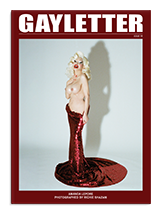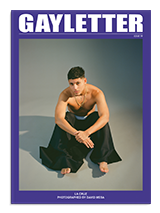
A still from the film 'Tom At The Farm'
The Real Thing
Xavier Dolan, an emerging filmmaker worth knowing
Although you may not recognize the name yet, Xavier Dolan at only 25 is poised to become a household name as a filmmaker producing movies in the grandest tradition of the silver screen. The Canadian born actor, writer, and director’s fourth feature, ‘Tom at the Farm,’ which was recently showcased at MOMA’s Carte Blanche film series honoring Miram Karmitz’s independent film company MK2, keeps this promise.
If you’re not familiar with Dolan’s work, much of his films read like extended music videos, with lush slow-motion sequences put to Salvatore Bono songs; but uniquely, here the videos enhance the music (see Dolan’s earlier films ‘I Killed My Mother‘ and ‘Heartbeats‘). There is also ‘Laurence Anyways,’ worth mentioning not least of all as a transgender narrative — although foremost a love story — told with the tenderness such deeply human stories deserve but are often deprived, and with a magic that makes the movie-going experience spellbinding when it’s good (and here it’s really good). The irresistible Melvil Poupaud, who stars as Laurence, makes for another strong reason to watch.
Representing a bit of a departure from these earlier projects, ‘Tom at the Farm’ opens on vistas of Canadian countryside as Tom, bereft of Guillaume, who has suddenly died by some accident that remains a mystery for the film’s entirety, travels to his late lover’s hometown, or farmtown as it were, to pay his respects. But upon his arrival, no one seems to have expected him or to have known of his existence prior. Tom, played by the oh-so-charming Dolan, nonetheless ekes his way into their lives with a shock of dirty blonde hair, a wounded heart, and the grace of a field mouse.
On the eve of the funeral we meet Guillaume’s older brother, Francis, the brooding and berserk bull of this cattle ranch who throws his weight and well-appointed jaw-line around like a juggernaut, threatening Tom with physical violence if he doesn’t keep to the story that Guilaume was straight and had a beloved girlfriend named Sarah. He achieves total domination through coercion and by exploiting Tom’s unstated sexual attraction, rasping in one scene after giving him a fresh beating, “I know you like me…please don’t go.” His stated motive for preserving his deceased brother’s straight image is to protect his grieving mother, played with haunting intensity by Lise Roy, the only hold-over from the original stage production by Michel Marc Bouchard upon which the screenplay is based.
Suspense and violence (and the threat of violent punishment) take center stage in the film, revealing the darkest modes of human desire. The tension crackles between Dolan’s Tom and Pierre-Yves Cardinal’s Francis, epitomizing the maxim that just on the other side of disgust is lust. Before you know it Tom, pale and purple, is in the grip of Stockholm syndrome, performing farm chores like an automaton under the hypnotizing gaze of his captor, having literally been beaten into submission. Even when a friend attempts to save him from his physically abusive, coke-snorting, man-on-man tango partner (yes that scene is as absurd and hot as it sounds), fretful Tom refuses rescue.
Dolan, fresh off of winning a jury prize at Cannes for his next project ‘Mommy,’ introduced ‘Tom at the Farm’ at MOMA. In his speech he referenced that in the midst of post-production he actually doubted the film’s quality, and that only after working with the film’s sound designer, Sylvain Brassard, did he realize sound’s power to reinforce storytelling. And indeed, one of the most absorbing features of the film is its expert sound design and menacing musical score. For instance, when Tom attempts to escape from Francis’s death-grip by diving into the scalloped sea of corn fields surrounding the farm (a visual that possesses on its own staggering beauty) the racing music raises the flesh to goosebumps. Gabreil Yared’s instrumentation leaves you dizzy yet again when, having abandoned another escape, Tom is hopelessly drawn back to the house of doom swooning in slow-motion on a symphonic groundswell. But, perhaps the most powerful example is during a monologue delivered by the matchless Roy, who, in painfully tight close-up remembers her son and curses the “accident” that struck him down at the age of 25. It is the terrible mounting strings in the background that complete this nausea-inducing reverie.
Dolan’s zeal for timing, suspense and drama have earned the film just comparisons to Hitchcock (and to that list I might add Stanley Kubrick’s ‘The Shining‘). What is most remarkable, however, is how Dolan turns the Hitchcokian formula on its head with Tom emerging as the quintessential Hitchcock heroine, subverting gender codes of cinema and most satisfyingly appealing to the Hitchcock heroine trembling within us all.
One of the film’s predominant themes is deception vs. reality. Peppered throughout are phrases like “feel real,” inscribed on a painting in the bedroom Tom share’s with his dead boyfriend’s brooding older brother, dividing their twin beds. And, yet again, appearing on a neon sign that reads “The Real Thing,” in a bar scene that speaks to Dolan’s exquisite writing, and a script that must read like a noir page-turner. Fed up with all of the lies, Tom asks a local bartender to tell him why all of the townspeople steer clear of Francis (as if he needed further explanation). It is a perfectly banal outpost in a perfectly normal farmtown where the agrarian normcore wet their whistles over a pint of lager. The bartender obliges, recounting a gruesome act of violence that, despite the scene’s absence of action, leaves you nonetheless riveted.
So what is “the real thing” in ‘Tom at the Farm’? Is it simply a marker by which we measure the central deception of the film, Gillaume’s grand lie to protect himself and his family from his sexual orientation – or is that, as Dolan points out himself “too on the nose”? Considering the blistering homoerotic tension between Francis and Tom one can’t help but wonder if Francis himself is a play on this theme of the “real”, here fetishized as the “real straight guy fantasy” whereby Tom is never entirely sure if Francis is going to fuck him or simply fuck him up. Maybe it’s a reference to the limitation of all human connection, whereby you love someone and think you know them only to wake up one day next to a stranger. Still more disturbing, perhaps it is about the stories will tell ourselves about ourselves that is the real gambit. Whatever the case, undoubtedly Dolan is the real thing and you’d be wise to hang a wish on this rising star.
Tom at the Farm will be featured again at MOMA on June 20th.
Chase Quinn is a New York based culture writer. Follow Chase on twitter @chasebquinn


